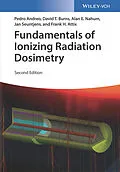Hervorragendes Lehrbuch, das die Konzepte der radiologischen Physik und Strahlungsdosimetrie verständlich präsentiert. Die Themen bauen logisch aufeinander auf und erleichtern das Verständnis. Unzählige Diagramme und Tabellen verdeutlichen die Konzepte.
Autorentext
The four authors continuing the pioneering work of Frank Attix, Prof Pedro Andreo (Karolinska, Stockholm), Dr David T. Burns (BIPM, Paris), Prof Alan E. Nahum (University of Liverpool) and Prof Jan Seuntjens (McGill University, Montreal), are leading scientists in radiation dosimetry, having published between them more than 600 papers in the field. They have co-authored most of the existing national and international recommendations for radiotherapy dosimetry and received a number of international awards for their contributions.
Zusammenfassung
A new, comprehensively updated edition of the acclaimed textbook by F.H. Attix (Introduction to Radiological Physics and Radiation Dosimetry) taking into account the substantial developments in dosimetry since its first edition. This monograph covers charged and uncharged particle interactions at a level consistent with the advanced use of the Monte Carlo method in dosimetry; radiation quantities, macroscopic behaviour and the characterization of radiation fields and beams are covered in detail. A number of chapters include addenda presenting derivations and discussions that offer new insight into established dosimetric principles and concepts. The theoretical aspects of dosimetry are given in the comprehensive chapter on cavity theory, followed by the description of primary measurement standards, ionization chambers, chemical dosimeters and solid state detectors. Chapters on applications include reference dosimetry for standard and small fields in radiotherapy, diagnostic radiology and interventional procedures, dosimetry of unsealed and sealed radionuclide sources, and neutron beam dosimetry. The topics are presented in a logical, easy-to-follow sequence and the text is supplemented by numerous illustrative diagrams, tables and appendices.
For senior undergraduate- or graduate-level students and professionals.
Inhalt
Preface xix
Quantities and symbols xxiii
Acronyms xxxix
1 Background and Essentials 1
1.1 Introduction 1
1.2 Types and Sources of Ionizing Radiation 1
1.3 Consequences of the Random Nature of Radiation 4
1.4 Interaction Cross Sections 6
1.5 Kinematic Relativistic Expressions 9
1.6 Atomic Relaxations 11
1.7 Evaluation of Uncertainties 22
Exercises 28
2 Charged-Particle Interactions with Matter 29
2.1 Introduction 29
2.2 Types of Charged-Particle Interactions 31
2.3 Elastic Scattering 36
2.4 Inelastic Scattering and Energy Loss 55
2.5 Radiative Energy Loss: Bremsstrahlung 95
2.6 Total Stopping Power 103
2.7 Range of Charged Particles 104
2.8 Number and Energy Distributions of Secondary Particles 106
2.9 Nuclear Stopping Power and Interactions by Heavy Charged Particles 112
2.10 The W-Value (Mean Energy to Create an Ion Pair) 114
2.11 Addendum Derivation of Expressions for the Elastic and Inelastic Scattering of Heavy Charged Particles 119
Exercises 139
3 Uncharged-Particle Interactions with Matter 143
3.1 Introduction 143
3.2 Photon Interactions with Matter 143
3.3 Photoelectric Effect 145
3.4 Thomson Scattering 154
3.5 Rayleigh Scattering (Coherent Scattering) 157
3.6 Compton Scattering (Incoherent Scattering) 161
3.7 Pair Production and Triplet Production 178
3.8 Positron Annihilation 188
3.9 Photonuclear Interactions 191
3.10 Photon Interaction Coefficients 193
3.11 Neutron Interactions 204
Exercises 211
4 Field and Dosimetric Quantities, Radiation Equilibrium Definitions and Inter-Relations 215
4.1 Introduction 215
4.2 Stochastic and Non-stochastic Quantities 215
4.3 Radiation Field Quantities and Units 216
4.4 Distributions of Field Quantities 219
4.5 Quantities Describing Radiation Interactions 220
4.6 Dosimetric Quantities 229
4.7 Relationships Between Field and Dosimetric Quantities 233
4.8 Radiation Equilibrium (RE) 239
4.9 Charged-Particle Equilibrium (CPE) 242
4.10 Partial Charged-Particle Equilibrium (PCPE) 248
4.11 Summary of the Inter-Relations between Fluence, Kerma, Cema, and Dose 252
4.12 Addendum Example Calculations of (Net) Energy Transferred and Imparted 252
Exercises 256
5 Elementary Aspects of the Attenuation of Uncharged Particles 259
5.1 Introduction 259
5.2 Exponential Attenuation 259
5.3 Narrow-Beam Attenuation 261
5.4 Broad-Beam Attenuation 263
5.5 Spectral Effects 270
5.6 The Build-up Factor 271
5.7 Divergent Beams The Inverse Square Law 273
5.8 The Scaling Theorem 276
Exercises 277
6 Macroscopic Aspects of the Transport of Radiation Through Matter 279
6.1 Introduction 279
6.2 The Radiation Transport Equation Formalism 280
6.3 Introduction to Monte Carlo Derived Distributions 286
6.4 Electron Beam Distributions 287
6.5 Protons and Heavier Charged Particle Beam Distributions 296
6.6 Photon Beam Distributions 301
6.7 Neutron Beam Distributions 309
6.7.1 Fluence Distributions 309
6.7.2 Dose Distributions 311
Exercises 313
7 Characterization of Radiation Quality 315
7.1 Introduction 315
7.2 General Aspects of Radiation Spectra. Mean Energy 316
7.3 Beam Quality Specification for Kilovoltage x-ray Beams 318
7.4 Megavoltage Photon Beam Quality Specification 326
7.5 High-Energy Electron Beam Quality Specification 331
7.6 Beam Quality Specification of Protons and Heavier Charged Particles 335<...
